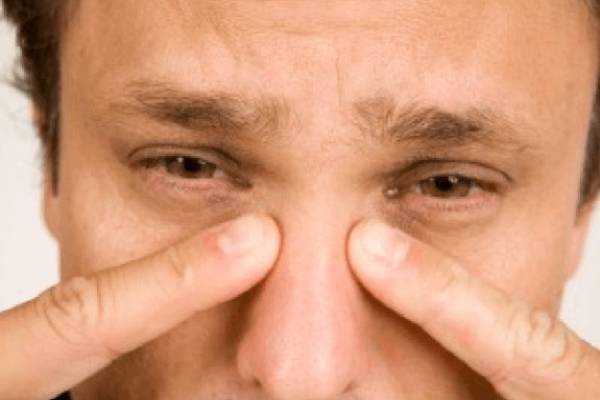Table of Contents
A nasal fracture means fracture and crack in the nasal bone that often occurs in the bone above the dorsum of the nose.
Common causes of nasal fracture include contact sports, physical fights, falls, and motor vehicle accidents that result in facial injuries. A nasal fracture can cause swelling and bruising around the nose and under the eyes. A person’s nose may look crooked and they may have difficulty breathing.
The nasal fracture usually heals within 3 weeks. If the condition does not improve or the person’s nose shape changes, you should see a doctor or hospital. Treatment for nasal fractures may include methods to repair the nose. Surgery is not usually necessary for a nasal fracture.
Symptoms of nasal fracture
Signs and symptoms of nasal fracture:
- Pain or tenderness especially when touching the nose
- Swelling in the nose and surrounding areas
- nose bleeding
- There is bruising around the nose or eyes
- Nasal congestion
- Difficulty breathing through the nose
- Discharge of mucus from the nose
- Feeling that one or both nasal passages are blocked
When to see a doctor
- See your doctor as soon as possible if you have any of the following problems with nasal fracture:
- Head or neck injury, which may be accompanied by severe headache, neck pain, vomiting, or loss of consciousness
- Difficulty breathing
- Unstoppable bleeding
- Significant changes in the shape of the nose that are not related to swelling, such as a crooked or twisted appearance
- Clear and watery discharge from the nose
Immediately after the injury, you should stop any bleeding and try to reduce the pain and swelling. Here are some things you can do until you see a doctor./ Rhinoplasty in Iran
What should be done immediately?
You need to stop any bleeding and try to reduce the pain and swelling. Do this until you see a doctor:
Stop the bleeding
- Sit – Do not lie down and do not lean on your back. The nose should be higher than the heart.
- Lean forward so that the blood does not reach the back of the throat.
- Hold your soft part of nose with your thumb and index finger and hold it firmly for 5 minutes.
- If the bleeding does not stop, hold your nose for another 10 minutes
Reduce pain
- Take painkillers such as acetaminophen or ibuprofen if needed.
- Put your head on several pillows and sleep.
Reduce inflation
- Wrap an ice pack in a towel. Put it on your nose for 10 minutes, then remove it for 10 minutes. Repeat this several times.
- Don’t put pressure on the ice pack – it may irritate your nose.
- Apply an ice pack or cold compress to your nose for at least four times a day for 2 days after the injury.
Things you should not do if you have nasal fracture symptoms
- If it’s deformed, don’t try to straighten your nose – see a doctor instead
- Do not wear glasses unless the swelling is gone, unless necessary.
- Avoid getting and cleaning your nose until it heals
- Do not do strenuous exercise for the first 2 weeks
- Avoid sports that may hit you in the face for up to 6 weeks.
Causes of nasal fracture
Common causes of nasal fracture include:
- Injuries caused by contact sports, such as football or hockey
- Physical disputes
- Motor vehicle accidents
- Falling
Nose fractures can occur even when hitting a fixed object while walking, such as on doors and walls, or when playing rough, such as wrestling.
How to diagnose nasal fracture
Your doctor can usually diagnose a nasal fracture by performing a physical checkup. This checkup includes viewing and touching the nose and face. If you have a lot of pain, your doctor may use local anesthesia to numb your nose before a physical checkup.
Your doctor may ask you to come back after two or three days after the swelling subsides to make it easier to see the injury. If the nose injury appears to be severe or is accompanied by other facial injuries, your doctor may order an X-ray or CT scan. These procedures can help determine the extent of damage to the nose and face.
Risk factors
Any activity that increases the risk of facial injury increases the risk of nasal fracture. Such activities may include the following:
- Do contact sports, such as football and hockey, especially without a helmet and face mask
- physical contact
- riding bike
- Weightlifting, especially if the assistance is not used
- Ride in a motor vehicle, especially without a seat belt
The groups that are most exposed to nasal fracture
Regardless of whether people are involved in sports or other physical activity, some groups are automatically at greater risk for nasal fractures. They are children and the elderly. There are specific concerns about bone health in both groups, and falls are common.
Children are more at risk for nasal fractures because their bone mass is still forming. Toddlers, especially young children, are more vulnerable.
Appropriate protective equipment should always be used during contact sports and physical activity.
Complications of nasal fracture
Complications or injuries related to nasal fracture may include the following:
- Septum deviation. A nasal fracture may cause a deviation in the septum, a complication that occurs when the thin-walled divider on either side of your nose (nasal septum) moves and narrows the nasal passage. Medications such as anticonvulsants (decongestants) and antihistamines can help relieve septal deviations, but surgery is needed to correct them.
- Accumulation of blood. Occasionally, blood clot cysts form as a result of a nasal fracture and cause a complication called septal hematoma. Septum hematoma can block one or both noses. Septum hematoma requires rapid evacuation and surgery to prevent cartilage damage.
- Cartilage fracture. If the fracture is due to severe shocks, such as a car accident, you may have a cartilage fracture. If the injury is severe enough to require surgery, the surgeon must repair both the bone and cartilage damage.
Prevention of nasal fracture
Here are some tips to help prevent nasal fractures:
- When using a motor vehicle, fasten your seat belt and keep children in child safety seats.
- Use recommended safety equipment such as helmets or face masks when performing contact sports such as hockey, football or other activities.
- Wear a helmet when cycling or riding a motorcycle.
Treatment of severe nasal fracture in hospital
If the nose is deformed
Your doctor at the hospital may be able to straight your nose using a procedure called manipulation.
You may need to go home and wait a few days for the swelling to subside, but surgery should be done within 14 days.
The manipulation is performed using anesthesia so that the person is asleep or the nose is numb. It doesn’t always make your nose look exactly like it did in the past, but it can often be helpful.
If a large wound has formed
The wound is usually cleaned and closed with sutures or hospital strips.
If the nosebleed does not stop
Your doctor may place a soft gas pad in your nose. A few days later, the pad is removed by a doctor.
Does the nose become the same as after the nasal fracture?
The nasal fracture heals without any problems. If you are dissatisfied with the way your nose heals or if you have trouble breathing normally, rhinoplasty is one of the choices.






